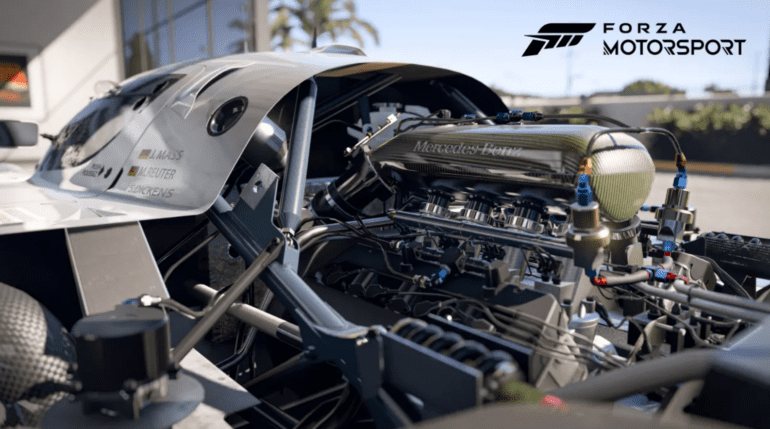TL;DR:
- Forza Motorsport employs advanced machine learning techniques to enhance AI-controlled opponents, resulting in the fastest and most realistic racing experience to date.
- The game leverages machine learning during the build time, allowing extensive data training to optimize the behavior of AI-controlled cars.
- Forza Motorsport prioritizes accessibility by offering a wide range of assist options, including one-button driving and customizable audio cues.
- The aim is to make Forza Motorsport the most inclusive racing simulation, catering to players of all skill levels and physical abilities.
Main AI News:
The Forza series has always been renowned for its awe-inspiring visuals and dedication to realism in the realm of virtual racing. From the iconic Mount Panorama Circuit in the inaugural game to the breathtaking Rally di Positano in the third installment and the stunning Castillo Del Mar in the fifth edition, each meticulously crafted setting provides a captivating backdrop for maneuvering high-end, true-to-life cars. Remaining true to this legacy, Forza Motorsport, the latest offering from Turn 10 Studios, continues to uphold these principles.
However, what truly sets Forza Motorsport apart and propels it toward the next level of racing simulation lies not only in its appearance and gameplay but in the groundbreaking processes driving its development. “One aspect I truly appreciate about working at Turn 10, as well as Xbox in general, is our inclination to tackle unconventional challenges within the gaming industry,” shares Forza’s general manager, Dan Greenawalt. Greenawalt is primarily referring to the revolutionary approach to machine learning embraced by Forza Motorsport, a paradigm shift that promises to redefine the racing genre as a whole.
Greenawalt explains that machine learning has long been utilized in the Forza series to power the behavior of AI-controlled characters that players compete against. In the pre-Xbox One era, a Bayesian machine learning system was employed, operating on the console’s local hard drive. However, this process has since migrated to the cloud, where Greenawalt and his team leveraged network capabilities to train the Drivatar—a term referring to AI-controlled opponents.
“With the latest iteration of Forza, we have taken machine learning to a new level by focusing on build time rather than run time or load time,” reveals Greenawalt. The training no longer occurs while the game is running or loading; instead, it transpires prior to the game’s launch. By training the Drivatar to control the vehicle and utilizing an optimizer to refine the path it follows, massive amounts of data are processed to ensure optimal performance across various conditions, including wet and dry tracks. Greenawalt emphasizes, “Our aim was to apply the machine learning techniques we were familiar with to a novel context.”
Through this groundbreaking approach, Greenawalt and his team have achieved unprecedented results. By implementing machine learning in a different facet of Drivatar, they have created the fastest AI opponents, devoid of any cheats or hacks, while maximizing the potential of this technology in a systematic and meaningful manner.
Collaborative Efforts
Another area where Forza has consistently excelled throughout its illustrious 18-year history is accessibility, and Forza Motorsport seeks to raise the bar even further. According to Chris Esaki, Motorsport’s creative director, Forza has long offered sophisticated assist options, catering to players of all skill levels. Esaki acknowledges the contribution of his colleague, Dan Greenawalt, in revolutionizing simulation racing with the introduction of the acclaimed driving line, much like Halo transformed the first-person shooter genre.
These assist options have evolved over the years, encompassing throttle assist, braking assist, and turning assist, all of which can be toggled on and off at the player’s discretion. Furthermore, the game now features enhanced levels of fidelity across these assists, including the introduction of one-button driving, allowing players to control the game with a single input. Whether steering, braking, or accelerating, players have the freedom to choose their preferred level of engagement.
Esaki goes on to explain that Forza Motorsport takes accessibility to new heights by incorporating audio assist features that streamline the gameplay experience like never before. These audio cues provide valuable guidance, such as when to turn before approaching a corner or signaling the proximity to the apex. “These audio assist cues are fully customizable, to the extent that if you enable them all, you could potentially drive blindfolded around the track. Our goal is to make Forza Motorsport the most inclusive racing simulation, catering to players of all skill levels. Regardless of visual impairment, speed preference, or experience level, everyone can enjoy this game to the fullest,” affirms Esaki.
While further details on these features are yet to be unveiled, both Esaki and Greenawalt assure enthusiasts that Forza Motorsport is poised to deliver an impressive gameplay experience that seamlessly combines accessibility with the franchise’s trademark visual appeal and authentic racing simulation feel.
Conclusion:
Forza Motorsport’s integration of machine learning and enhanced accessibility features marks a significant leap forward for the racing simulation market. The utilization of machine learning during the build time allows for unprecedented AI performance and an authentic racing experience. Furthermore, the expanded accessibility options, including customizable audio cues, cater to a broader audience, ensuring that players of all skill levels and abilities can enjoy the game to its fullest potential. These advancements position Forza Motorsport as a trailblazer in the industry, setting new standards for realism, innovation, and inclusivity.

